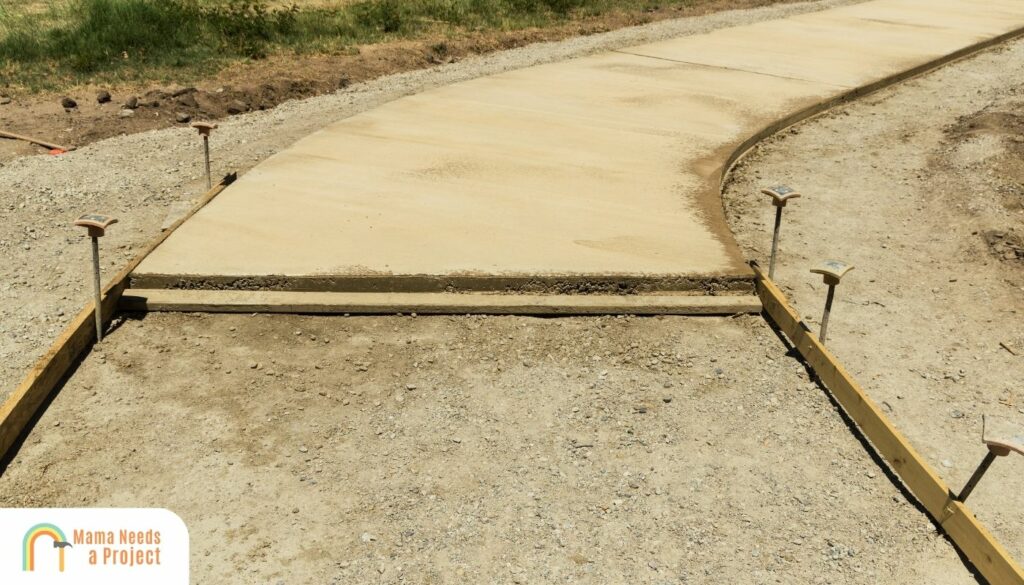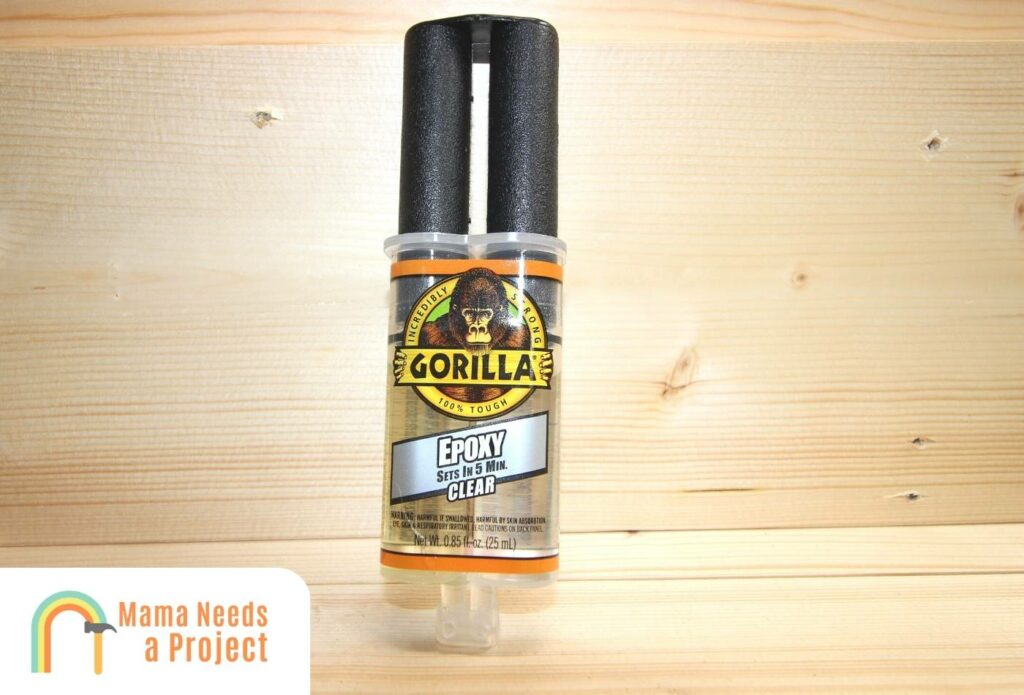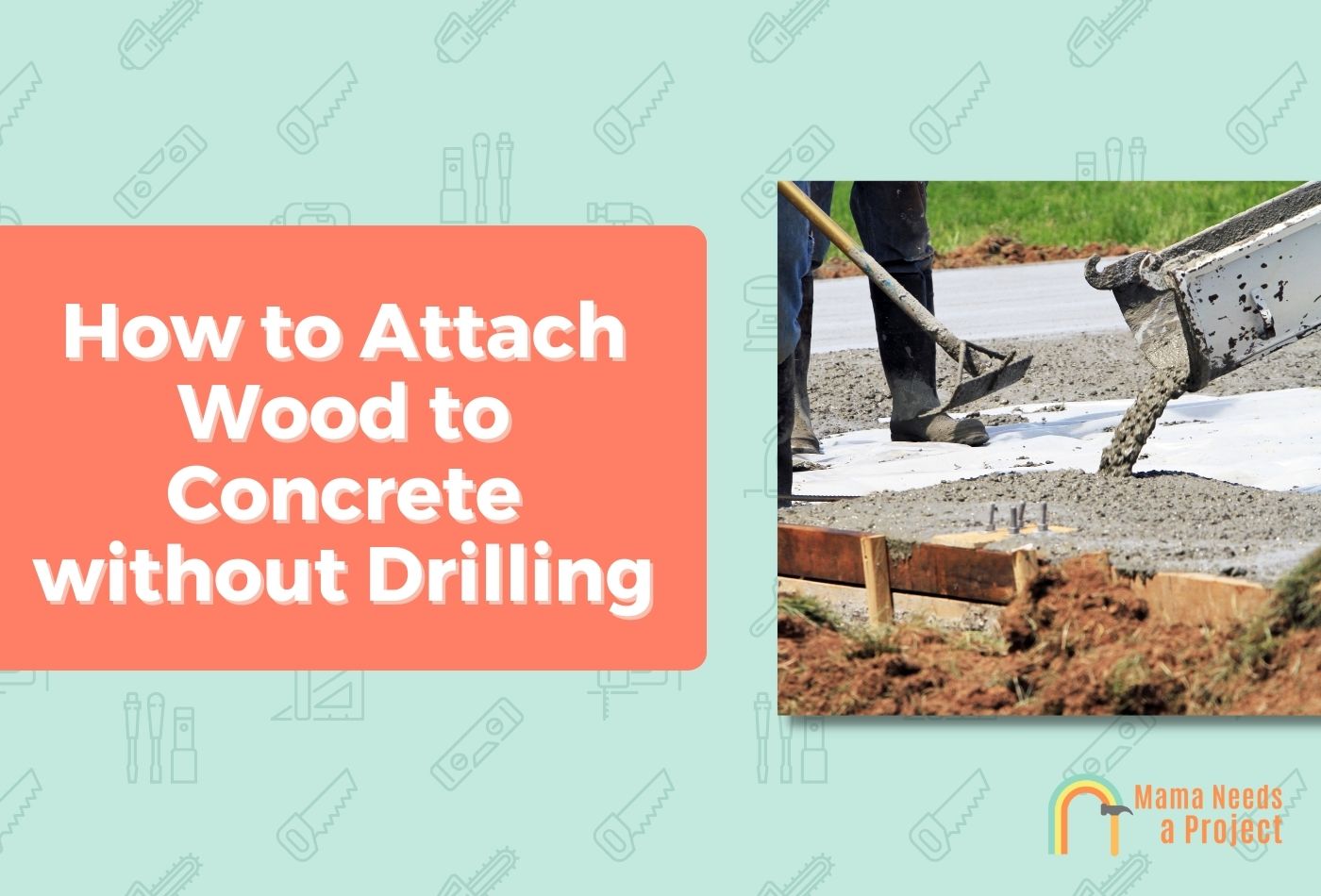How to Attach Wood to Concrete without Drilling (7 EASY Ways)
Whether you’re an avid DIYer, making repairs around the home, or performing a remodel, you might run into a situation where you need to attach wood to concrete.
While you can attach wood to concrete by pre-drilling holes and inserting screws, this is messy, loud, and difficult. Additionally, not everyone has a hammer drill lying around and waiting to be used.
If you’re attaching wood to concrete and don’t want to mess with drilling holes, you have plenty of options to choose from. Some methods are more difficult than others, but they will all get the job done.
- Some of the best ways for bonding wood to concrete include using concrete nails, using a nail gun, using hardware hangers, and using construction adhesive or epoxy glue.
- To bond wood to concrete, be sure the surface has completely cured and is dry.
Can You Attach Wood to Concrete Without Drilling Holes?
While attaching wood to concrete by drilling holes is a common option, it’s not the only one. As long as you have the right materials and make the necessary preparations, there are many other ways to fasten wood to concrete without drilling.
7 Ways to Attach Wood to Concrete

1. Concrete Nails and a Sledgehammer
One of the first methods you can attempt for attaching wood to concrete is to use masonry or concrete nails and pound them in with a sledgehammer. While this is one of the cheapest methods, it’s also one of the most difficult because you’ll need a ton of power and force to pound nails into concrete.
While using a traditional steel hammer is lighter, you risk creating sparks if you whack the head of a steel hammer against the top of a steel nail. As such, you should always use a sledgehammer, which is much heavier but safer. You’ll also make it clear that you mean business when you’re wielding a sledgehammer one-handed!
Additionally, you can use the sheer weight and momentum of the sledgehammer to your advantage. Be sure to hit the nails directly on the top of the head to ensure it gets driven in straight and true. The nail should be long enough to penetrate the wood and stick roughly one inch into the concrete.
If you want a stronger bond, you can also consider concrete screws – but obviously you can’t use a sledgehammer to secure them.
2. Air Powered Nail Gun
If a sledgehammer sounds like too much work, you can use an air-powered nail gun. This option is much easier and requires less force than a sledgehammer.
However, unless you’re a carpenter, there’s a good chance you don’t have an air-powered nail gun lying around the house. As such, you’ll have to purchase, rent, or borrow one from a friend, neighbor, or home improvement store.
It’s also worth noting that there’s a bit of a learning curve to using an air-powered nail gun. They tend to kick profusely if you don’t use them properly, and could lead to damaging the wood, the concrete, or yourself. Additionally, if the concrete is brittle, the force of the nail gun could cause it to crack as the nail enters it.
3. Hardware Hangers
If you’re attempting to attach wood to a concrete wall, another option is to use hardware hangers. Hardware hangers can easily be found at your local hardware or home supply store and are fairly easy to use. However, they typically have weight restrictions and can only support around twenty pounds.
Hardware hangers will have small pins with pointed ends built into the hanger. By placing the pointed end against the wall and hitting it with enough force, you can attach it to the wall and then attach wood to the hanger. The tricky part will be finding hardware hangers that are strong and durable so that the ends won’t break when you try to pound them into concrete.
4. Adhesive Wall Hooks
If you can’t find hardware hangers strong enough to pound into concrete, you can opt for adhesive wall hooks instead. Rather than getting driven into concrete, the adhesive on the wall hooks sticks to the wall.
To apply adhesive wall hooks to concrete walls, make sure that the surface of the concrete is clean, dry, and smooth. Peel away the paper backing on the adhesive to reveal the sticky surface. Next, press the sticky portion of the wall hook against the concrete surface and hold it firmly in place for 30 seconds.
On the front side of the hook, there’s a second paper backing with a sticky adhesive underneath. Follow the same procedure as you did above: remove the paper, press the wood firmly against the adhesive, and hold it in place for 30 seconds.
While adhesive wall hooks are quick and easy to apply, they aren’t a good option for heavy wood. On average, these hooks can only support eight pounds and only work on smooth concrete surfaces and walls.
5. Industrial Velcro
Using industrial velcro is another viable way to fasten wood to concrete surfaces. Industrial velcro works very similarly to adhesive wall hooks. The back side of the velcro will have an adhesive that sticks to the wall. However, it will have velcro rather than a bond on the front side.
To apply this attachment method, remove the paper covering on the back of the velcro and press it firmly against the concrete wall. Next, remove the paper covering on a second piece of velcro and attach it to the wood or craft you want to fasten to the wall.
With both adhesives applied, press the velcro portions against each other and hold them in place for several seconds. Industrial velcro is slightly stronger than adhesive wall hooks and can support more weight. However, they have limitations, and there’s a good chance you’ll damage the wall beneath the adhesive when you remove it because of how sticky it is.
6. Epoxy Glue Adhesive

If you want an easy, durable way to attach wood to anything, epoxy glue or construction adhesive is the way to go. Epoxy glue is easy to apply, but the concrete surface you’re sticking it to must be clean and completely dry. Otherwise, it won’t be able to bind properly and won’t form a tight connection.
Epoxy glue and similar fasteners are good for attaching to concrete walls, floors, and anything in between. The key to using glues and liquid adhesives is to apply just the right amount. Too much, and you’ll be wasteful and make a massive mess, but too little, and the wood won’t stick to the concrete permanently.
7. Powder Actuated Fasteners
Finally, you can use powder-actuated fasteners to bind wood to concrete securely. If you’ve ever spent time on a construction site when the builders are fastening walls to poured concrete floors, you’ve likely seen them using this attachment method.
Rather than relying on brute force or an air gun to permanently attach wood to concrete, powder-actuated fasteners use a powder charge and concrete nail guns. The operation is similar to firing an actual gun, as it uses a .22 caliber cartridge that ignites when the air gun’s hammer strikes it.
This provides the power necessary to firmly drive nails through wood boards and deep into the concrete below. The pins used with powder-actuated fasteners have small pegs on them to ensure they don’t pull out of place. Use ear and eye protection when using this method because firing a powder-actuated pin is the same principle as firing a gun, and it has the spark and sound to match.
Can You Use Glue to Attach Wood to Concrete?
Using glue or liquid adhesive is a good option to quickly, easily, and permanently attach wood to concrete. Glue, such as Liquid Nails and Gorilla Glue, are becoming increasingly popular among homeowners and construction professionals alike.
In fact, Liquid Nails and other construction adhesives are sometimes required when attaching wooden wall bases to concrete floors. This is especially true when there are water, gas, or electrical lines beneath the concrete that you want to avoid driving nails or screws into.
To properly use glue or liquid nails, follow these simple instructions.
- Ensure the concrete surface is completely dry, clean, and free from debris or dust before applying the glue.
- Wait to apply the glue until the temperature is between 65 and 95 degrees. Cold weather will slow the drying process and make so that the wood doesn’t properly adhere to the concrete, as will overly hot temperatures.
- There mustn’t be too much humidity in the air or dampness in the concrete, as this won’t allow for proper wetting properties or attachment.
- Apply the adhesive evenly, and be careful not to get carried away and add too much. Adding too much adhesive won’t interfere with its ability to bind materials together, but it’s messy and wasteful.
- Use a zig-zag pattern to apply the glue. You can do this on the concrete’s surface or the wood itself.
- Press the wood and concrete together and use weights to hold the concrete in place for the recommended time. Depending on the product you’re using, the drying time of construction adhesive will usually be from 8 to 24 hours.
- If any glue squeezes out from beneath the wood when you apply pressure, use a wet rag to clean it up to avoid stains and sticky messes.
Check out the video below for more details on gluing wood to concrete!
Precautions When Attaching Wood to Concrete
While it’s possible and practical to attach wood to concrete without drilling, it’s important to remember that there are precautions you should use when doing so. When you understand these precautions, you can decide which attachment method is right for you.
Concrete Cracking
One of the biggest risks of using hammers, nail guns, or powder-actuated fasteners is that it can cause concrete cracking. The sheer force and pressure exerted using these methods can be too much for concrete to handle, especially if it’s brittle or old.
The Wood Comes Loose
The second thing to worry about is that if you use the wrong type of fastener or adhesive, the wood you’re trying to attach could pull loose. Concrete and masonry nails don’t have grooves to hold them firmly in place as screws do, so shifts in the wood or concrete can make them wiggle loose.
This can also happen with wall hooks and wall adhesives that have weight limitations. The only tried, and true way of holding wood firmly in place is to use a flexible adhesive and follow the manufacturer’s instructions to a T.
The Glue Doesn’t Stick
When you follow the manufacturer’s instructions and apply glue properly, there’s almost no chance of it coming loose. However, if you rush the process or apply glue to a surface that’s moist, too cold, or not properly prepared, there’s a chance that the glue won’t stick.
Check out this guide to learn if (and how) to use wood stain on concrete!
Personal Injury
Anytime you’re doing any construction or craft activities involving wood, concrete, and attaching the two, it’s essential to be safe. This is especially true when using a sledgehammer, an air-powered nail gun, or powder-actuated fasteners.
To avoid injury, wear goggles, ear protection, and long sleeves to protect against sparks. Additionally, if you’re using glue or adhesive, have water and a solvent nearby in case you get it stuck to your hands.
FAQs
Can you attach wood directly to concrete?
If you’re attaching wood to concrete, you don’t need a barrier between the materials. Place the wood directly against the concrete and implement your preferred attachment method.
Which liquid glue is best for attaching wood to concrete?
If you want to use liquid glue to attach wood to concrete, your best bet is to use epoxy or polyurethane adhesives. These materials create a strong bond and are flexible enough to shift with the concrete.
What is the easiest way to attach wood to concrete?
Liquid nails or an epoxy-based adhesive are the easiest way to attach wood to concrete without drilling. If you have the tools and the know-how, the most permanent solution for nailing wood to concrete is to use powder-actuated fasteners.
Final Thoughts About How to Attach Wood to Concrete Without Drilling
As you can see, there are plenty of great ways to attach wood to concrete without drilling holes.
The key to long-term success is to choose the method that’s right for you. If you have access to the right tools and equipment, powder-actuated fasteners or epoxy glue is the way to go.
However, if you’re in a hurry and only need to provide temporary support for crafts or small shelves, velcro, wall hooks, and hardware hangers will get the job done. As long as you choose the right attachment option for your needs and follow the instructions, you shouldn’t have any difficulty attaching wood to concrete.

